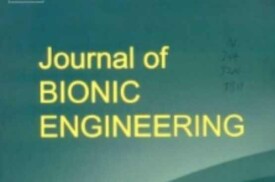仿生工程學報
仿生工程學報
《 仿生工程學報》是經國家新聞出版總署批准,吉林大學主辦,中華人民共和國教育部主管,國內由著名的科學出版社出版發行,國際由最負盛名的Elsevier出版公司出版發行,以工程仿生學科為特色的國際性英文學術期刊,是國際仿生工程領域唯一的學術類英文專業期刊。
該刊辦刊宗旨是報道國內外工程仿生學科重要的、優秀的、創新性的研究成果。為該領域及相關領域的研究人員提供發表新信息的園地和交流學術思想的論壇。為促進工程仿生研究成果轉化為生產力、加速這一新興、交叉、邊緣學科實現跨越式、突破性的發展服務。主要報道涉及仿生科學與工程所有方面的原始論文和綜述。包括動植物仿生工程方面的基礎研究(動物的運動和行為,植物和天然材料的結構、成分、形態和物理特性)以及這些基礎研究在工程、技術和設計方面的應用。本刊現已被國際檢索系統SCI、EI、AJ、CSA收錄。
《Journal of Bionic Engineering》編委會由中國、英國、美國、加拿大、德國、日本、比利時、奧地利、荷蘭、羅馬尼亞、巴西、印度、泰國等國的仿生學專家組成。主編為國際著名仿生學者任露泉教授。副主編由英國巴斯(Bath)大學仿生技術中心主任、國際著名仿生學家Julian F.V. Vincent教授和吉林大學佟金教授擔任。
《Journal of Bionic Engineering》以國際化的編委陣容、高素質的編輯隊伍、高檔次的排版印刷質量、一流的辦刊條件起步,堅持正確的辦刊方向,突出仿生學科特色,廣泛挖掘仿生工程界優秀的、創新性研究成果。本刊所有來均嚴格遵循同行評審,堅持高學術標準。稿件的編輯加工均堅持執行國際慣例,保證英語水平,凡非母語英語作者的論文一律送母語為英語的編委評審和潤色。
《Journal of Bionic Engineering》現為季刊,每季度末出版,並在同步發行電子版。
2006年JBE被EI收錄,2007年被SCI收錄
2013年、2016年《仿生工程學報》連續兩次獲“中國科技期刊國際影響力提升計劃”支持。
2009年IF=0.973 ;2010年IF=1.032;2011年IF=1.023 ;2012年IF=1.144;2013年IF=1.333;
2014年IF=1.632。
主要報道涉及仿生科學與工程所有方面的原始論文和綜述,包括動植物仿生工程方面的基礎研究,以及這些基礎研究在工程技術和設計方面的應用。
Submission of manuscripts
Submission of an article implies that the work described has not been published previously and is not under consideration for publication elsewhere (except in the form of an abstract or academic thesis or presentation in conference).
Upon acceptance of an article, authors will be asked to transfer copyright to the publisher. This transfer will ensure the widest possible dissemination of information.
Preparation of manuscripts
Microsoft Word (*.doc or *.docx) should be used.
1. Manuscripts should be written in English. Authors whose native language is not English are strongly advised to have their manuscripts checked by an English-speaking colleague prior to submission.
2. Manuscripts should be prepared in single column with wide margins and double spacing throughout. Every page of the manuscript, including the title page, references, tables,etc.should be numbered. All variables and Greek letters should be in italic, and all constants should be in Roman. Vectors or matrix variables should be inbold italic.
3. Manuscripts in general should be organized in the order: Title page, Abstract, Keywords, Text, Acknowledgement, References, Figures, Tables, List of figure captions.
Title page:This page should contain a concise and descriptive title with no more 80 characters, name(s) of author(s), affiliation(s), city, zip code, country, full telephone, E-mail of the corresponding author.
Abstract:The abstract should be clear, informative and not longer than 300 words to outline the objective, method and main results.
Keywords:Authors are asked to provide 3 to 6 items for cross-indexing of this paper. The keywords should be placed below the abstract with one space line apart from it.
Text:The text should contain anIntroductionto put the paper in proper perspective for the audience,MaterialsandMethods,ResultsandDiscussion, andConclusionsections. Section and subsection headings must be numbered in the decimal system, e.g.1,1.1,1.1.1etc.; section and subsection headings should not be run within the text; they should be typed on a separate line, without indentation. Uppercase is used only for the first letter of the first word of the headings. Equations should be numbered consecutively in Arabic numerals in parentheses on the right-hand margin and cited in the text, e.g. Eq. (2).
Illustrations:Each illustration must be prepared on a separate page;never embodyingthe illustrations in theText. Illustrations should be companied by appropriate captions and numbered according to their sequence in the text, e.g. Fig. 1, Fig. 2a. The text should include references to all illustrations. A separate page should be used to list the captions of the illustrations at the end of the manuscript. The width of a single column illustration is 8 cm and that of a double page illustration is 16 cm; therefore, if possible, make illustrations close to these two sizes; otherwise, attention should be paid that after reduction the illustrations should be clearly readable. In illustrations, the data line should be thicker than the axes.
Tables:Each table must be prepared on a separate page;never embodyingthe tables in theText. Each table should have a brief and self-explanatory title and be numbered according to its sequence in the text, e.g. Table 1, Table 2. The text should include references to all tables. The headings of columns should include proper abbreviations of units in parentheses, e.g. (g), (mm). Any explanation essential to the understanding of the table should be given as a footnote at the bottom of the table.
Acknowledgements:Individuals or groups other than the authors who were of direct help in the work should be acknowledged. Information on research grants should be mentioned here.
References:References should be typed on separate page. All references should be numbered in Arabic numerals according to their sequence in the text and bracketed, e.g. [1], [2,3] and [4–7] as superscripts. Personal communications and unpublished data are not acceptable as references. Different kinds of references should be referred to as follows.
lPapers in periodicalsshould be referred in the order: name of author(s), title of paper, name of periodical (in italic), year, Vol.(in bold), pages. For example:
[1] Vincent J F V. Dynamics of drying in phenolically tanned materials.Journal of Bionic Engineering, 2004,1, 4−8.
lBooksshould be referred to in the order: name of author(s), title of books (in italic), publishing house, city, year, pages. For example:
[2] Ren L Q.Optimum Design and Analysis of Experiments,
2nd ed, Higher Education Press,Beijing, 2003. (in Chinese)
lPapers in conference proceedingsshould be referred to in the order: name of author(s), title of paper, name of conference (in italic), city, country, year, pages. For example:
[3] Ren L Q, Tong J, Li J Q, Chen B C. Soil adhesion and biomimetics of soil-engaging components in anti-
adhesion against soil: A review.Proceedings of the13th International Conference of ISTVS,Munich,Germany, 1999, 233−240.
lWebsite online publicationshould be referred in the order: name of author(s) (if available), title of paper or web page, [date], website address. For example:
[4]Stockman A, Sharpe L T.Color & Vision Database, [2005-04-05],http://cvision.ucsd.edu
OFFPRINTS
Ten free offprints of each paper will be provided to the corresponding author.
